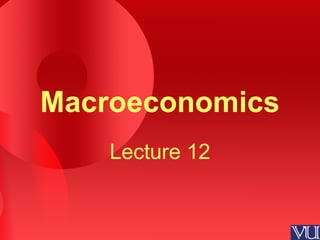
Lecture12
- 2. Review of the Previous Lecture • Quantity Theory of Money (Cont.) –Money Demand –Inflation and Money Growth –Inflation and Interest Rates
- 3. Topics under Discussion • Money Demand and Interest rate –Money demand Function • Why is inflation Bad? • Classical View of Inflation
- 4. The Fisher Effect • The Fisher equation: i = r + π –S = I determines r . –Hence, an increase in π causes an equal increase in i. –This one-for-one relationship is called the Fisher effect.
- 5. Exercise: Suppose V is constant, M is growing 5% per year, Y is growing 2% per year, and r = 4. a.Solve for i (the nominal interest rate). b.If SBP increases the money growth rate by 2 percentage points per year, find ∆i . c.If the growth rate of Y falls to 1% per year What will happen to π? What must SBP do if it wishes to
- 6. Answers: First, find π = 5 − 2 = 3. Then, find i = r + π = 4 + 3 = 7. b. ∆i = 2, same as the increase in the money growth rate. c.If SBP does nothing, ∆π = 1. To prevent inflation from rising, SBP must reduce the money growth rate by 1 percentage point per year.
- 7. Two real interest rates ∀π = actual inflation rate (not known until after it has occurred) ∀πe = expected inflation rate • i – πe = ex ante real interest rate: what people expect at the time they buy a bond or take out a loan • i – π = ex post real interest rate: what people actually end up earning on their bond or paying on their loan
- 8. Money demand and the nominal interest rate • The Quantity Theory of Money assumes that the demand for real money balances depends only on real income Y. • We now consider another determinant of money demand: the nominal interest rate. • The nominal interest rate i is the opportunity cost of holding money (instead of bonds or other interest-earning assets). • Hence, ↑i ⇒ ↓ in money demand.
- 9. Linkages Among Money, Prices and Interest rate Money Supply Money Demand Price Level Inflation Rate Nominal Interest Rate
- 10. The money demand function (M/P )d = real money demand, depends negatively on i i is the opp. cost of holding money positively on Y higher Y ⇒ more spending so, need more money (L is used for the money demand function because money is the most liquid asset.) ( ) ( , )d M P L i Y=
- 11. The money demand function When people are deciding whether to hold money or bonds, they don’t know what inflation will turn out to be. Hence, the nominal interest rate relevant for money demand is r + πe . ( ) ( , )d M P L i Y= ( , ) e L r Y+= π
- 12. Equilibrium ( , )eM L r Y P = + π The supply of real money balances Real money demand
- 13. What determines what variable how determined (in the long run) M exogenous (SBP) r adjusts to make S = I Y ( , )eM L r Y P = + π ( , )Y F K L= P adjusts to make ( , ) M L i Y P =
- 14. How P responds to ∆M • For given values of r, Y, and πe , a change in M causes P to change by the same percentage --- just like in the Quantity Theory of Money. ( , )eM L r Y P = + π
- 15. What about expected inflation? • Over the long run, people don’t consistently over- or under-forecast inflation, so πe = π on average. • In the short run, πe may change when people get new information.
- 16. What about expected inflation? EX: Suppose SBP announces it will increase M next year. People will expect next year’s P to be higher, so πe rises. • This will affect P now, even though M hasn’t changed yet.
- 17. How P responds to ∆πe ( , )eM L r Y P = + π (the Fisher effect)e iπ↑ ⇒ ↑ ( ) d M P⇒ ↓ ( )to make fall to re-establish eq'm P M P⇒ ↑ • For given values of r, Y, and M ,
- 18. The social costs of inflation …fall into two categories: 1. costs when inflation is expected 2. additional costs when inflation is different than people had expected.
- 19. Summary • Money Demand and Interest rate –Money demand Function • Why is inflation Bad? • Classical View of Inflation
- 20. Upcoming Topics • Social Costs of Inflation • Additional Cost of unexpected and High Inflation • Hyperinflation
Hinweis der Redaktion
- This exercise gives students an immediate application of the Quantity Theory of Money and the Fisher effect. The math is not difficult.
- Answers---the details: a. First, we need to find . Constant velocity implies = (M/M) - (Y/Y) = 5 - 2 = 3. Then, i = r + = 4 + 3 = 7. b. Changes in the money growth rate do not affect real GDP or its growth rate. So, a two-point increase in money growth causes a two-point increase in inflation. According to the Fisher effect, the nominal interest rate should rise by the increase in inflation: two points (from i=7 to i=9). c. = (M/M) - (Y/Y). If (Y/Y) by 1 point, then will increase by 1 point; the Fed can prevent this by reducing (M/M) by 1 point.
